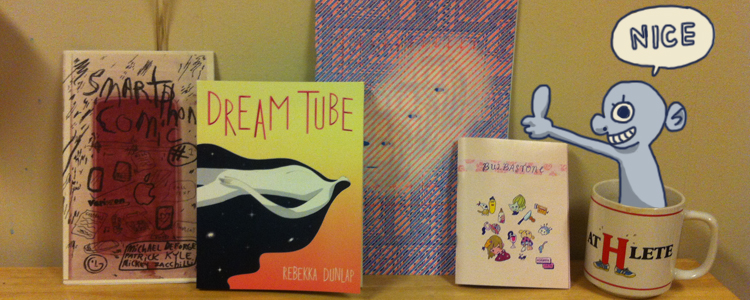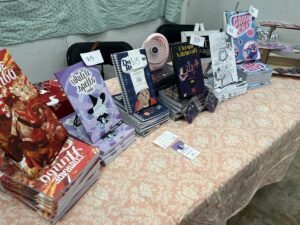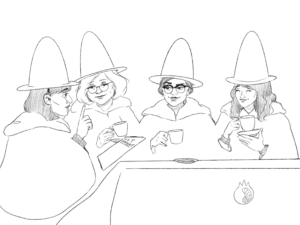TCAF (or, the Toronto Comic Arts Festival) is this weekend and the lineup of guests looks amazing as always. I’m not going, but it’s nice to know there will be a bunch of exciting comics and zines premiering there which (fingers crossed!) should be available online shortly after. In the meantime, however, I’ve been catching up on some of the stuff that came out over the past couple of months without the aid of a major festival. Today, and unlike previous editions of this column, I’ll be giving brief thoughts on a few of those books.
Smartphone Comic #1 – Mickey Zachilli, Michael Deforge, Patrick Kyle

For the past three years or so, alt-cartoonists Mickey Z, Michael Deforge and Patrick Kyle have been releasing these snack-sized theme zines every few months. Don’t let the “#1” in the title fool you: most likely this will be the only Smartphone Comic before the trio turns their creative energies towards something completely different (previous #1’s have included stuff like Basketball Comic #1, Xmas Comic #1, Medicine Comic #1, etc.). Like past issues, the comics contained within are absurd, playful and fairly ironic — these are not fan-zines and it’s clear no one cares all that much about the subject matter. Rather, like children rifling through a chest of toys or a costume closet, each theme is only meant to focus the cartoonists’ attention together for a moment. As soon as the jolt of inspiration passes, the old theme is abandoned for a new one and the game starts over again. It’s a wholly unpretentious style of experimentation and just generally good bang for your buck!
Smartphone Comic #1 can be found at Mickey Z’s store, along with a lot of other cool stuff (I especially recommend the Dealing with Winter zine). More work by Patrick Kyle can be found at his site. More work by Michael Deforge can be found by throwing a dart at a pile of comics anthologies but here’s his site anyway.
Bulbastone – Minipete

Mileage will probably vary on this sketch-zine from tumblr artist Minipete. I doubt anyone would try to deny the cuteness on display (also available as sticker-packs and postcards!) but I understand that not everyone is necessarily interested in doodles and rough drafts. Personally, I find this sort of peek into an artist’s process fascinating and have long believed that many artists do their best work in sketchbooks. I also have a real fondness for yuru-chara (or, Japanese-style mascots (check out this blog!) and Bulbastone is brimming with them.
More art can be found at Minipete’s tumblr page. Bulbastone seems to have sold out entirely while I was writing this review. My bad!
Silica Burn – Liam Cobb, Tom Kemp, Will Tempest

Emphatically not cute is this collection of future-focused short stories printed in London. Silica Burn is a stylistically diverse but thematically cohesive book with some major misgivings about the ability of technology to improve our lives. Whether this skepticism was totally coincidental or the intended theme of the comic as a whole, all three artists have built their stories around the failure of technology to fulfill its promises. In Cobb’s Arcade Dreams, a fashionable mall-walker seeks out a Disney-inspired romance simulation but, just like Cinderella, is ejected from the fantasy just as it starts to get good. The man in Kemp’s Monk Mode seeks self-improvement while working his job of remotely maintaining a rich family’s home, but mostly seems to use the bathroom and spout trite aphorisms. The one-armed artist in Tempest’s Phantom Limb is blessed with access to cyborg body parts, but his frustration with his robotic arm is obvious even before he snaps his pencil in the last panel. The gap between each character’s desires or aspirations and their actual lives is rendered repeatedly obvious. That people in the future, like people in the present, will continue to be unsatisfied or frustrated with their lives isn’t an especially novel insight. But the cartooning of Silica Burn is excellent and these are intriguing glimpses into very plausible worlds – futures similar to our own, if only we had stranger hats.
Silica Burn is available here if you can stomach the international shipping rate. More work by Cobb, Kemp and Tempest can be found at their respective websites.
Dream Tube – Rebekka Dunlap

Dunlap describes herself as an illustrator first and her comics reflect the refined skillset of a pro. She builds both characters and their settings from strong, geometric shapes and her compositions favor clarity over realism. Her drawings are beautiful but they’re also efficient, precise and immanently readable. Perhaps this is why her narrative choices are all so wonderfully ambiguous. When illustrating, for example, a New Yorker article, the artist must encapsulate an idea and work in support of the text. In these instances, clarity is key because there is a “right answer.” The illustration is necessarily about something. To be sure, the three stories in Dream Tube seem to be about something too, but the “what” is not so readily obvious. Brooklyn Witch Tweets is the sort of hip infusion of fantasy-elements into contemporary life familiar to anyone who’s read Scott Pilgrim or Super Mutant Magic Academy but lacking those stories’ clear protagonists. Cities and Spaces and is a short, odd dream sequence about a city under siege which is framed by a couple discussing this dream. The longest and last story, Colony, features a mysterious mission-gone-wrong in an unexplained sci-fi setting. On the surface, these stories are unrelated and perhaps even confined within their respective genres. However, themes and bits of imagery repeat throughout the book, piercing each story’s autonomy: a woman/man couple, a disembodied eye, passages, portals and doorways. What exactly each story is about individually and how (or if!) they connect and what it all points to is left uncertain. But the reader gets the unshakable sense of something deeper at work. In her own words, Dunlap “draws comics about the things we feel but can’t explain” and it seems she does so with the same precision that she brings to her illustrative work. Maybe it’s this paradox that keeps pulling me back into Dream Tube. The feeling that a nail has been hit on the head, but not being able to find it afterwards.
Dream Tube can be purchased from the website of the publisher, Youth in Decline and more work by Rebekka Dunlap can be found at her website.
If it’s obvious to you what Dream Tube is about, please email me so that I don’t look too foolish the next time I talk to someone about it. Thanks!




